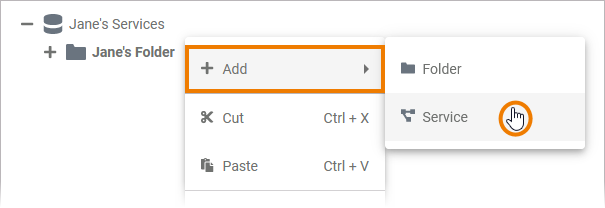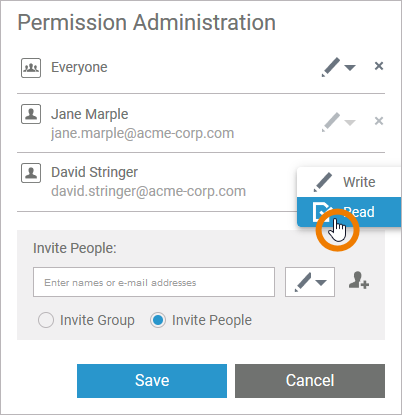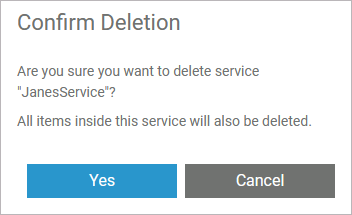Services
A Service contains one executable micro service. Services are created in the Explorer tree. The necessary settings for your service such as the service properties, the BPMN model, the data model, used libraries and forms are managed within the service. You need to open a service to access its contents via the Service panel, refer to Service Panel for details.
Creating a Service
Add a service to manage the necessary settings for your microservice. A service can only be created in folders. To add a service to a folder, right click on the folder and select option Add > Service from the context menu:

Enter a name for the service in the pop-up window Create New Service. Click Save:

If you want to deploy the service to a container later, please note that on container deployment the service name is automatically changed according to certain rules.
Naming of Services for Container Deployment
Example:
Service Name: Janes_First_Service
Container Name: janes-first-service
The two services in this example would get the same container name...
... so they would overwrite each other.
Restrictions on Element Names
The only restriction for folder names is that they must not be empty.
To all other elements in the Explorer, the following name restrictions apply:
Element names...
... must not be empty.
... must not contain spaces.
... must not start with numbers.
... must not end with a period (.).
... must not contain one of the following characters: <, >, :, ", /, \, |, ?, *
Furthermore, the following strings must not be used as element names: CON, PRN, AUX, NUL, COM1, COM2, COM3, COM4, COM5, COM6, COM7, COM8, COM9, LPT1, LPT2, LPT3, LPT4, LPT5, LPT6, LPT7, LPT8, LPT9.
Your input is validated. You can only save a valid element name:

The new service is created and displayed in the tree:

To open a service, click on the service name in the explorer tree.
The Service tab will open.
The service details will be displayed on the right side of the tree.

To access the service, click on the the explorer tab icon or on the service details area to close the explorer tab. Refer to Service Panel for further information.
The Service Context Menu
Right click a service to open its context menu:

The context menu displays all options available for a service:
Cutting and Pasting
If you want to use an element at a different position in the tree, select the context menu option Cut:

Open the context menu of the element in which you want to insert the cut element and select Paste:

Option Paste is only enabled if the elements to be inserted fit into the tree hierarchy. Pasting elements is only possible in the same namespace.
The element is now displayed on its new place in the tree:

Exporting and Importing
You cannot import elements into a service. But it is possible to export services from folders. For detailed information refer to Exporting and Importing Explorer Contents.
Managing the Service Permissions
You can set access restrictions on several levels:
On a namespace:
Namespace permission can be set in the User Management. These permissions have the highest priority. If a namespace with e.g. read-only permissions is assigned to the user in the User Management, You cannot override this permission in the Designer. For further information refer to the Scheer PAS Administration Guide.On a folder:
Folder permissions affect all sub-elements of the folder, but you can assign permissions to a service within the folder independently.On a service:
Service permissions only affect the corresponding service.
Select the option Permissions in the context menu if you want to manage the access to a service:

In the pop-up window Permission Administration you can invite single colleagues or whole groups to access the element. By default, the creator of the element and everyone sharing the current namespace has write permissions:

To limit access to the element you can remove the group Everyone completely, or give it read-only permission.
If you want to restore permissions for Everyone,
select option Invite Group,
search for group Everyone and add it again.
If you want to add other users, first select one of the options:

Invite Group: Allow whole user groups to access your element. Available groups are all distribution lists that have been created as a Role in the user management.
Invite People: Add single users to your element and grant them read or write permission.
Refer to Managing Roles in the Administration Guide for detailed information about roles.
Enter the name or email address of the group or person to the search field. Matching results are shown in a list. Select the entry you want to use:

Use option Add Person to add the selected user or group:

Once the user or group has been added, you can specify whether the user or the group should have read or write permission. Save your changes:

Sharing a Service
You can also share the link for a service. Select Share from the context menu to copy the link of the service to the clipboard:

The action is confirmed by a toast message:

You are now able to paste the URL, for example to an email:

Renaming the Service
If you want to change the name of a service, select Rename:

Enter the new name in the pop-up window Edit Service. Click Save:

Restrictions on Element Names
The only restriction for folder names is that they must not be empty. To all other elements in the Explorer, the following name restrictions apply:
Element names...
... must not be empty.
... must not contain spaces.
... must not start with numbers.
... must not end with a period (.).
... must not contain one of the following characters: <, >, :, ", /, \, |, ?, *
Furthermore, the following strings must not be used as element names: CON, PRN, AUX, NUL, COM1, COM2, COM3, COM4, COM5, COM6, COM7, COM8, COM9, LPT1, LPT2, LPT3, LPT4, LPT5, LPT6, LPT7, LPT8, LPT9.
The new name is displayed in the tree:

Deleting a Service
To remove a service from the tree, open its context menu and select Delete:

Confirm the security prompt in the pop-up window with Yes to delete the service from the tree:

Please note that all contents of the service are also deleted.
Related Pages:
Related Documentation:
